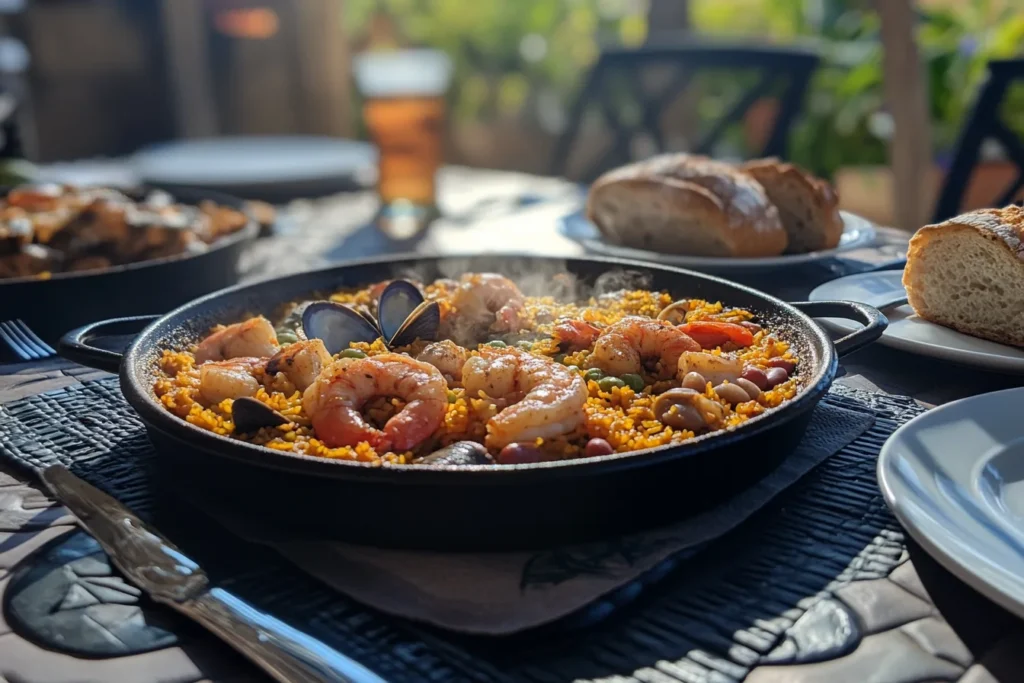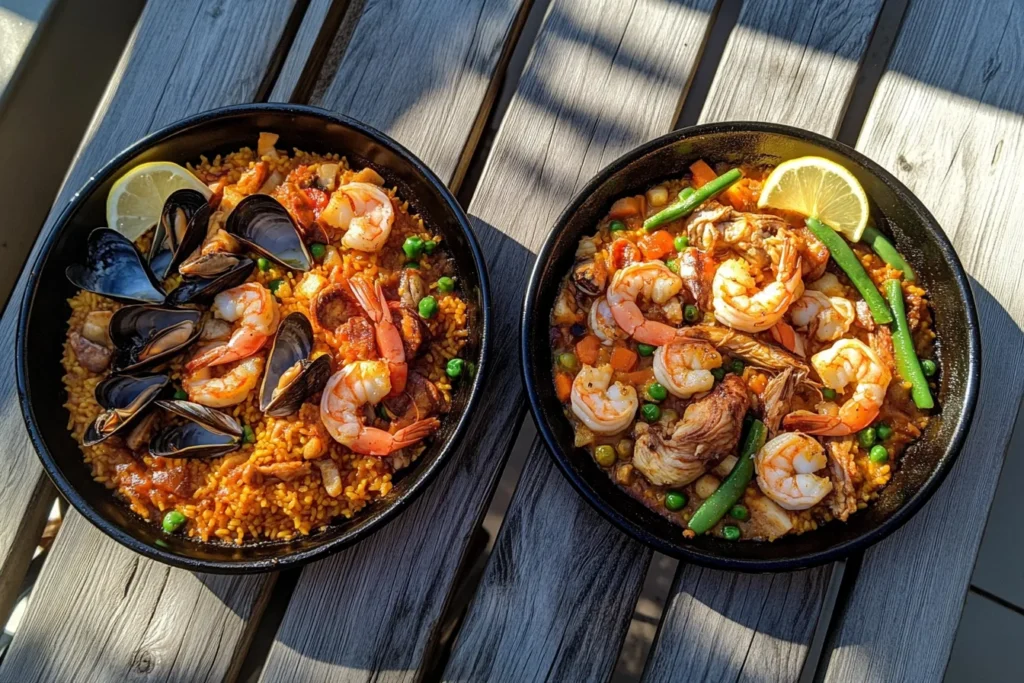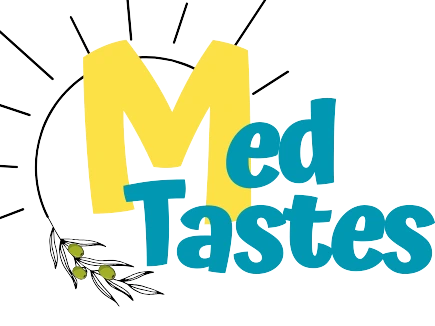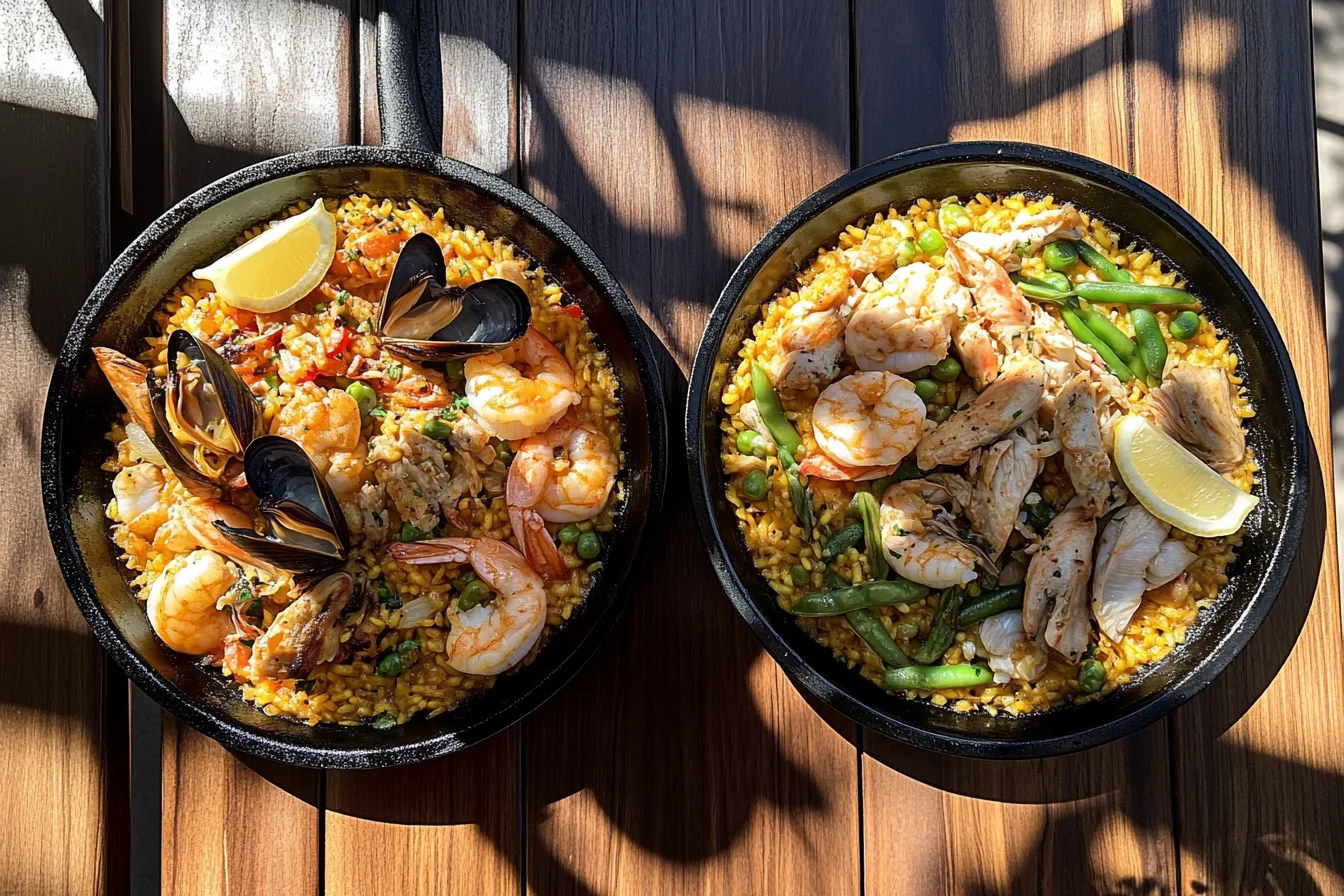Table of contents
Paella, the iconic Spanish dish, has captivated food lovers worldwide with its vibrant colors, aromatic flavors, and rich cultural heritage. Two of the most popular versions, Paella de Mariscos and Paella Valenciana, stand out as culinary masterpieces in their own right. While both share the same basic cooking method, their ingredients and flavors are distinctly different, each telling a unique story of Spain’s diverse culinary landscape.Paella de Mariscos, with its bounty of seafood, reflects the coastal regions’ love affair with the Mediterranean Sea. On the other hand, Paella Valenciana, originating from the fertile lands of Valencia, showcases the agricultural richness of the Spanish countryside.
Paella de Mariscos: A Seafood Lover’s Dream
The Ocean’s Bounty in a Pan
Paella de Mariscos, also known as seafood paella, is a coastal delight that showcases the best of the Mediterranean’s marine offerings. This version is a far cry from its landlocked cousin, focusing entirely on the treasures of the sea. The dish is a celebration of the ocean’s bounty, bringing together a variety of seafood in a harmonious blend of flavors and textures.
Key Ingredients
The star players in Paella de Mariscos include:
- Succulent shrimp
- Tender squid or calamari
- Flavorful mussels and clams
- Firm white fish like cod or snapper
Also these seafood delicacies are nestled in a bed of saffron-infused rice, creating a harmonious blend of flavors. However, the ingredients can vary depending on the chef’s preference and the availability of fresh seafood. For example, some versions might include lobster or crab for an extra touch of luxury.
Cooking Technique
Paella de Mariscos is typically prepared in a wide, shallow pan called a paella. The rice is cooked to perfection, absorbing the rich flavors of the seafood and spices. A crucial element is achieving the socarrat, a crispy layer of rice at the bottom of the pan. This golden crust is considered a delicacy and adds a delightful texture to the dish.
The cooking process begins with sautéing aromatic vegetables like onions and garlic in olive oil. Next, the rice is added and toasted slightly before the broth is poured in. The seafood is then arranged on top of the rice, allowing it to cook gently as the rice absorbs the flavorful liquid. Consequently, each grain of rice becomes infused with the essence of the sea.
Learn more about Paella de Mariscos!
Regional Variations
While Paella de Mariscos is popular throughout Spain’s coastal regions, there are subtle variations depending on the locale. For instance, in Catalonia, you might find a version called “Arròs negre” or black rice, which gets its distinctive color from squid ink.
Pairing Suggestions
To complement the rich flavors of Paella de Mariscos, a crisp white wine is often the beverage of choice. Albariño from Galicia or a dry Verdejo from Rueda can beautifully enhance the seafood’s delicate flavors. Additionally, a cold Spanish beer can be a refreshing accompaniment, especially on a warm summer day.

Paella Valenciana: The Traditional Favorite
A Taste of the Spanish Countryside
Paella Valenciana, hailing from the region of Valencia, is considered the original paella. This hearty dish reflects the agricultural roots of its birthplace. Unlike its seafood counterpart, Paella Valenciana is a celebration of the land, incorporating ingredients that were readily available to farmers and laborers in the rural areas of Valencia.
Traditional Ingredients
The classic Paella Valenciana consists of:
- Chicken and rabbit meat
- Green beans (bajoqueta)
- Lima beans (garrofó)
- Artichokes (in season)
- Snails (optional)
These ingredients are combined with rice, saffron, and other spices to create a robust, earthy flavor. The use of meat and vegetables gives this paella a distinctly different character from its seafood cousin. Furthermore, the inclusion of snails, while optional, adds a unique touch that speaks to the dish’s rustic origins.
Authentic Preparation
Traditionally, Paella Valenciana is cooked over an open fire, infusing it with a subtle smoky taste. The dish is often prepared for large gatherings and served directly from the pan. This communal style of eating is an integral part of the paella experience, fostering a sense of togetherness and shared enjoyment.
The cooking process begins with browning the meat to develop deep flavors. As with Paella de Mariscos, achieving the perfect socarrat is crucial. However, the flavors here are more robust and earthy compared to the delicate seafood version.
Historical Significance
Paella Valenciana has a rich history that dates back to the 18th century. Originally, it was a humble dish prepared by farm workers using whatever ingredients were available. As time went on, it evolved into a symbol of Valencian cuisine and Spanish culture as a whole. In fact, it became so significant that today, it is recognized as a cultural icon. Moreover, there are ongoing efforts to have it declared an Intangible Cultural Heritage by UNESCO. This recognition underscores not only the dish’s importance in culinary traditions but also its role in fostering community and cultural identity among the people of Valencia.
Seasonal Variations
While the basic ingredients of Paella Valenciana remain consistent, there are seasonal variations. For example, artichokes are typically added in the spring when they’re at their peak. In the summer, ripe tomatoes might play a more prominent role. These seasonal adjustments ensure that the dish always showcases the best produce available.
Wine Pairings
To complement the rich, meaty flavors of Paella Valenciana, a medium-bodied red wine is often recommended. A Tempranillo from Rioja or a Garnacha from Priorat can stand up to the dish’s robust character. Alternatively, a full-bodied white wine like a Valencian Merseguera can also be an excellent choice.

Nutritional Comparison
Here’s a quick look at the nutritional differences between these two paella varieties:
| Nutrient | Paella de Mariscos (per serving) | Paella Valenciana (per serving) |
|---|---|---|
| Calories | 450-500 | 500-550 |
| Protein | 25-30g | 20-25g |
| Fat | 15-20g | 20-25g |
| Carbs | 50-60g | 60-70g |
It’s worth noting that these values can vary depending on the specific ingredients and proportions used. Generally speaking, Paella de Mariscos tends to be slightly lower in calories and fat, while higher in protein due to its seafood content. On the other hand, Paella Valenciana is often more calorie-dense and higher in carbohydrates, reflecting its heartier, land-based ingredients.
Cooking Methods and Techniques
The Importance of the Right Pan
Both Paella de Mariscos and Paella Valenciana are traditionally cooked in a special pan called a paella. This wide, shallow pan is crucial for achieving the correct rice texture and the coveted socarrat. The large surface area allows for even heat distribution and promotes the formation of that crispy bottom layer.
The Art of Rice Cooking
Cooking the rice properly is perhaps the most critical aspect of making a great paella, regardless of the variety. The rice should be firm to the bite (al dente) while having absorbed all the flavorful broth. This requires careful attention to the liquid-to-rice ratio and cooking time.
Achieving the Perfect Socarrat
The socarrat, that prized layer of crispy rice at the bottom of the pan, is a hallmark of a well-made paella. To achieve this, the heat is typically increased towards the end of the cooking process. The key is to create a crisp texture without burning the rice. This technique requires practice and a keen sense of timing.
The Role of Saffron
Both types of paella typically include saffron, which imparts a distinctive yellow color and unique flavor. However, due to its high cost, some recipes substitute saffron with more affordable alternatives like turmeric or food coloring. Purists, however, insist that true paella must include real saffron.

Cultural Significance and Traditions
Regional Pride
Both Paella de Mariscos and Paella Valenciana are sources of regional pride. Valencians, in particular, are very protective of their traditional paella recipe. In fact, in 2013, the Valencian government officially declared the ingredients that constitute an authentic Paella Valenciana.
Paella in Spanish Culture
Paella has become a symbol of Spanish cuisine worldwide. It’s often the dish that tourists seek out when visiting Spain, and it’s frequently featured in promotional materials for Spanish tourism. This has led to both positive recognition and some concerns about oversimplification of Spanish culinary diversity.
Modern Interpretations and Fusion Cuisine
Contemporary Twists on Classic Recipes
While traditionalists might frown upon deviations from the classic recipes, many modern chefs are putting their own spin on paella. This might involve using non-traditional ingredients or incorporating techniques from other cuisines. For instance, some chefs are experimenting with vegetarian or vegan paellas, replacing meat or seafood with a variety of vegetables and plant-based proteins.
Paella-Inspired Dishes
The popularity of paella has inspired dishes in other cuisines. For example, “paella” risottos have appeared on menus, combining the concept of paella with the creamy Italian rice dish. Similarly, paella-flavored arancini (Italian rice balls) showcase a fusion of Spanish and Italian culinary traditions.
Global Ingredients in Paella
As global ingredients become more accessible, some chefs are incorporating international flavors into their paellas. This might include using exotic spices, tropical fruits, or ingredients from Asian or Middle Eastern cuisines. While purists might argue that these creations are no longer true paellas, they represent the evolving nature of cuisine in an interconnected world.
Environmental Considerations
Sustainable Seafood in Paella de Mariscos
With growing concerns about overfishing and marine conservation, there’s an increasing focus on using sustainable seafood in Paella de Mariscos. Some restaurants and home cooks are also exploring the use of farmed seafood as a more sustainable option.
Local and Seasonal Ingredients in Paella Valenciana
The traditional Paella Valenciana already emphasizes local, seasonal ingredients. However, there’s a growing movement to further this approach, with some chefs focusing on hyper-local sourcing and adapting the recipe based on what’s available in their immediate area. This not only ensures freshness but also reduces the carbon footprint associated with transporting ingredients over long distances.
Health Considerations
Nutritional Benefits
Both types of paella can be part of a healthy diet when consumed in moderation. Paella de Mariscos is rich in omega-3 fatty acids from the seafood, which are beneficial for heart and brain health. Paella Valenciana, with its mix of meat and vegetables, provides a good balance of proteins and fiber.
FAQs
Q: Can I mix seafood and meat in my paella?
A: While it’s not traditional, some modern recipes do combine seafood and meat. However, purists might argue that this creates a paella mixta, not a true Valenciana or de Mariscos. If you’re cooking at home, feel free to experiment with combinations that appeal to you.
Q: What type of rice is best for paella?
A: Short-grain rice varieties like Bomba or Calasparra are ideal for paella. They absorb flavors well while maintaining their structure. These varieties can absorb more liquid than long-grain rice, resulting in a creamier texture without becoming mushy.
Q: Is paella difficult to make at home?
A: While it requires some practice, making paella at home is definitely doable. The key is having the right pan and ingredients, and paying attention to the cooking process.
Q: Can I make paella on a regular stovetop?
A: Yes, you can make paella on a regular stovetop. While traditional methods often use an open flame, many home cooks successfully prepare paella on their kitchen stoves. The key is to ensure even heat distribution, which might require rotating the pan occasionally.
Conclusion
In conclusion, both Paella de Mariscos and Paella Valenciana are masterpieces that reflect the rich cultural heritage of Spain. While Paella de Mariscos delights seafood lovers with its fresh marine flavors, Paella Valenciana offers a hearty taste of the Spanish countryside with its robust mix of meats and vegetables. Each dish has its own unique preparation methods, ingredients, and historical significance, making them not just meals but also stories of tradition and community. Whether you prefer the briny goodness of the sea or the rustic charm of the land, both paellas promise a delightful dining experience that brings people together. So why not gather your loved ones and dive into the world of paella? Your taste buds will thank you!

